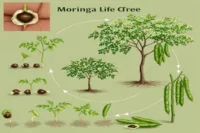A Complete Growing Guide: Radish Plant Growth Stages
Published: 28 Jul 2024
Radishes are vibrant, peppery root vegetables. They delight the taste buds and are rich in nutrients. In this blog post, we will study the incredible growth stages of radish plants and explore the world of these beautiful, excellent plants.
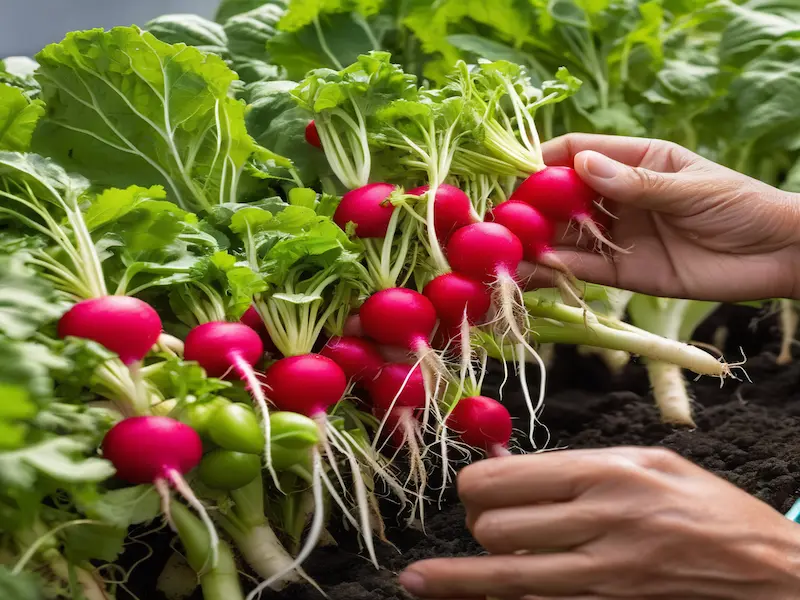
Radishes Origination
Radishes originally came from Southeast Asia and have long been grown all over the world. Ancient civilizations, such as the Egyptians, Greeks, and Romans, loved radishes for their taste and health benefits.
Radishes are now a common ingredient in many types of food worldwide. Their crunchy texture and spicy flavor make them great for salads, sandwiches, and pickles. They are also healthy and full of vitamins C and K, fiber, and antioxidants, which are good for overall health.
Radish Growth Chart
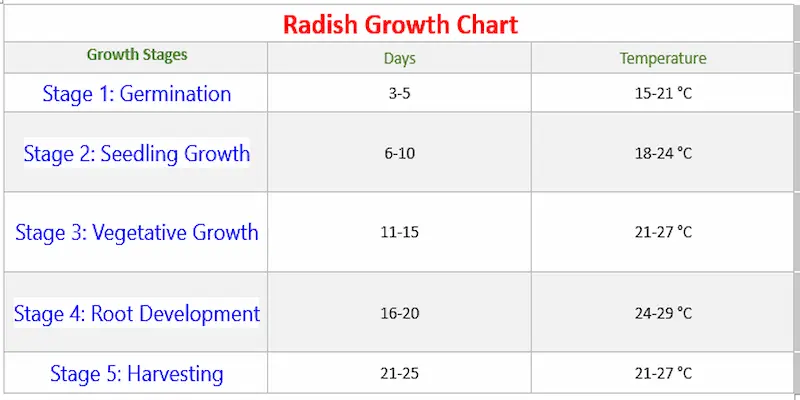
Radish Growth Time
Radish’s growth time is speedy. From planting the seeds to the maturity level of the radishes, it takes only about 3 to 4 weeks. When you plant the seeds in your garden, tiny sprouts appear in a few days. These sprouts quickly turn into leafy green plants. For a pest-resistant garden, try interplanting radishes with https://mybestvegetables.com/mustard-crop/, a natural trap for harmful insects.
Soon, you will see radishes growing under the soil. In just a few weeks, they are ready to pick and eat. Radishes are great for salads and snacks, and they are super easy to grow!
Stage 1: Germination
Understanding radish seeds
The process of radish plant growth starts with germination. Radish seeds are tiny powerhouses of life. Growing radishes helps to know what’s inside these seeds. Each seed has a tiny plant inside, protected by a seed coat. When conditions are right, the seeds begin to sprout.
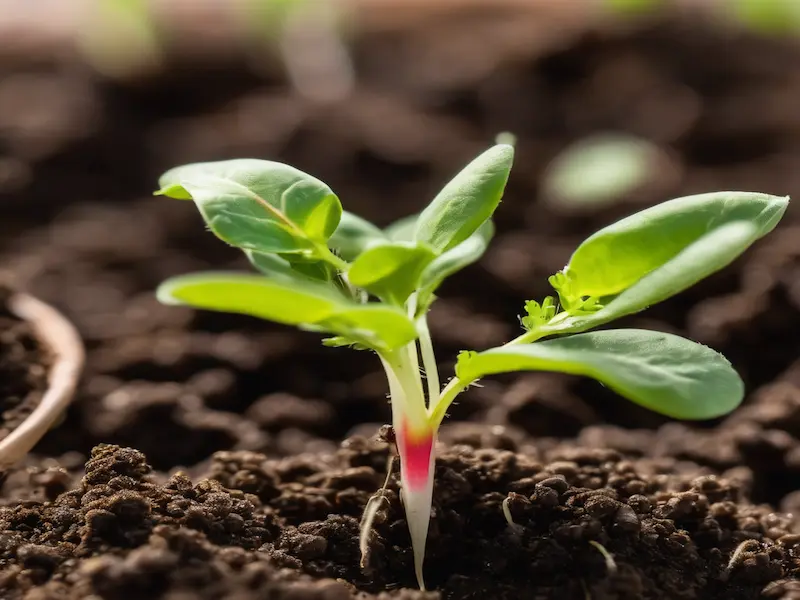
Radish Germination Temperature
Radish seeds need the right temperature to germinate. The best temperature for radish germination is between 55°F and 75°F (13°C to 24°C). If the soil is too cold, the seeds do not sprout; if it’s too hot, they can dry out or grow well.
Planting radish seeds in cool spring or fall weather gives them the best chance to succeed. When the soil is moist and wet, the seeds germinate well. With the right temperature and care, radish seeds will sprout quickly and grow into healthy plants.
Germination process of Radish Plant Growth Stages
Once the seeds are ready, the germination process starts. The seeds first soak up water. Then, the tiny root, called the radicle, begins to grow. During this time, enzymes become active, and cells divide to form the root and shoot systems.
The seeds’ temperature, moisture, and quality all affect how fast and well they sprout. With the right conditions, the seeds will grow quickly and become healthy plants.
Stage 2: Seedling Growth
Appearance and characteristics of radish seedlings
As the seeds germinate, radish seedlings emerge, revealing the first signs of radish plant growth stages. The cotyledons, also known as seed leaves, develop and provide the initial nutrients until the plant can sustain itself. Root and shoot systems start forming, setting the foundation for future growth.
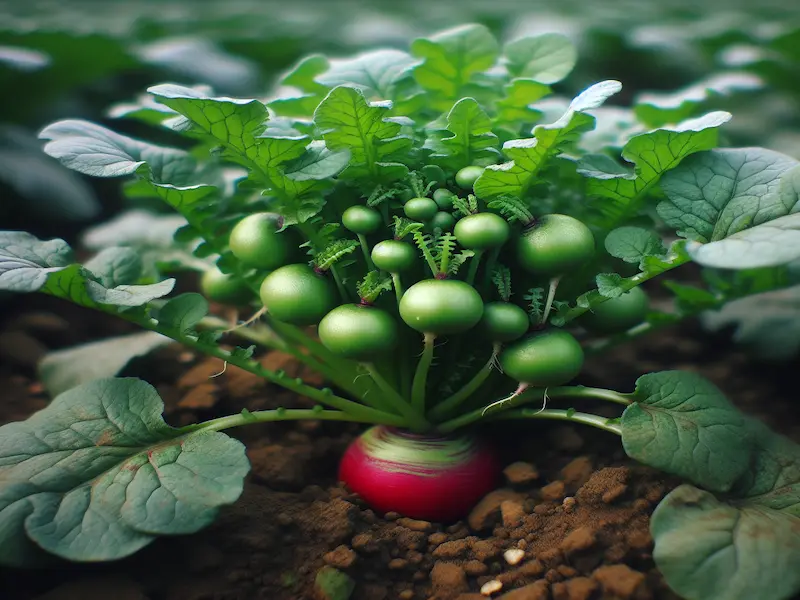
Nurturing healthy seedlings
The right environment is crucial for healthy seedling development. Choosing appropriate soils ensures adequate space and nutrients for the growing radish plants. Proper lighting, temperature maintenance, and optimal moisture levels are essential for nurturing robust seedlings.
Common challenges and solutions
Seedlings can face various challenges during their early stages, including pest infestation and diseases. Protecting them from harmful insects and pathogens is necessary for their survival. Additionally, preventing overwatering and addressing nutrient deficiencies on time can promote the growth and vitality of seedlings.
Stage 3: Vegetative Growth of Radish Plant Growth Stages
Leaf development and expansion

After seedlings, the following process is known as vegetative growth. These radish plants growth stages focus on leaf development and expansion. Leaves are the primary site for photosynthesis, enabling the plants to manufacture food. Understanding leaf structure, photosynthesis, and growth patterns sheds light on the fascinating processes within these green appendages.
Root system development
While leaves take centre stage during radish plants’ vegetative growth stages, the roots silently establish a strong foundation below the surface. Radish plants possess different types of root systems, such as taproots and fibrous roots, each with unique characteristics. Root growth and health also significantly influence soil quality, moisture levels, and cultural practices.
Promoting optimal vegetative growth
Proper spacing and thinning techniques are crucial to promote optimal vegetative growth. Giving radish plants enough room to spread their leaves ensures optimal airflow and light penetration. Thinning out crowded seedlings prevents competition for resources, resulting in enhanced growth. Understanding fertilization requirements and implementing best practices further contributes to robust vegetative growth.
Stage 4: Reproductive Phase of Radish Plant Growth Stages
Flowering and pollination
The transition from vegetative growth to the reproductive phase marks a significant milestone in the life of a radish plant. Under the right conditions, radishes develop beautiful flowers and depend on pollinators for successful reproduction. The presence of specific environmental cues and the availability of pollinators play vital roles in the flowering and pollination processes.
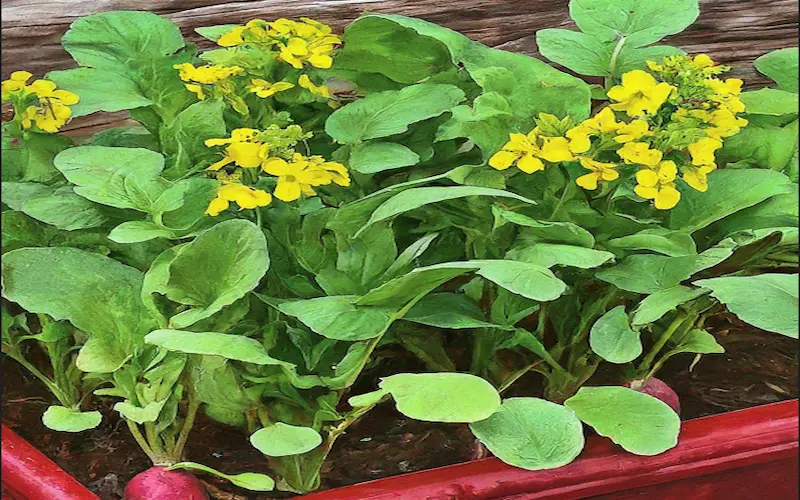
Seed production and maturation
As flowering progresses, radishes shift their focus from leaves to seed production. The vegetative structures change, redirecting resources toward creating seeds. Understanding the vegetative-to-reproductive transition sheds light on the intricacies involved in seed maturation.

Role of pollination in radish varieties
Radish varieties can be classified into open-pollinated, hybrid, and genetically modified types. Pollination plays a crucial role in preserving seed purity for open-pollinated varieties. On the other hand, hybridization and genetic modification techniques manipulate the reproductive process to achieve desired traits but may impact the natural purity of the seeds.
How to Grow Radishes indoors
Growing radishes indoors is a rewarding venture for gardening enthusiasts and those who love fresh produce at their fingertips. Firstly, choose a six-inch-deep container to accommodate the radish’s growth. The container should have a drainage hole at the bottom to prevent waterlogging.
In the next step, fill your container with a quality potting mix, leaving about an inch from the top. Radishes perform better in well-drained soil, so avoiding heavy garden soils that may hinder their growth is advisable. Sow your radish seeds about half an inch deep into the soil and space them about two inches apart to allow for adequate growth.

Position your container in a location that receives at least six hours of sunlight daily. If natural light is limited, supplement with grow lights. Regular watering is essential, but avoid overwatering, as it can lead to rot.
Finally, monitor your radishes’ growth and be ready to harvest typically within 4-6 weeks from planting. The quick turnaround makes radishes an ideal vegetable for indoor gardening, providing fresh, crisp produce in a relatively short period. Healthy radishes are a product of reasonable care, so ensure optimal conditions for their growth and development.

Harvesting and Culinary Uses
Determining when radishes are ready to harvest
Harvesting is an essential aspect of growing radishes. You can determine the optimal time for harvesting from some factors, like visual cues and maturity indicators. Different radish varieties have varying maturation times, so paying attention to these signs is crucial.
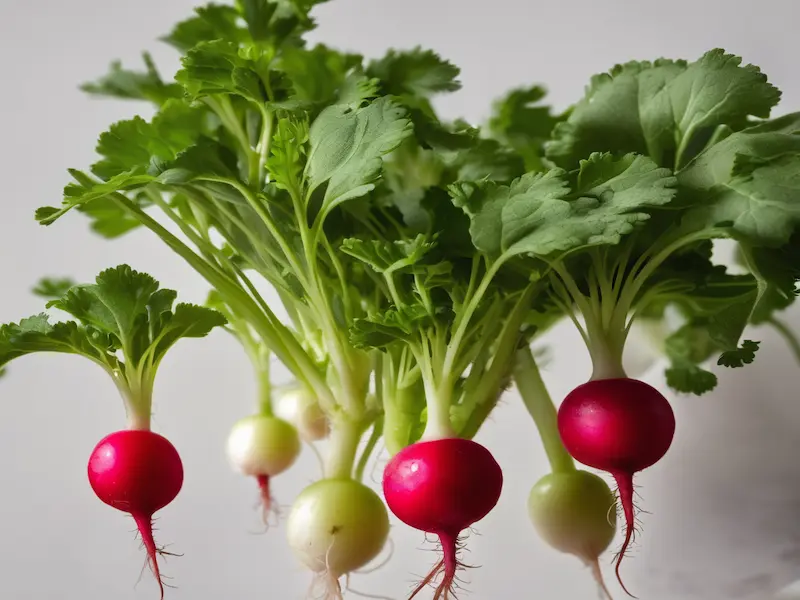
Harvesting techniques and tips
Proper handling during the harvesting process helps prevent damage to the radishes. Techniques such as gently loosening the soil, holding the radish crown firmly, and avoiding excessive twisting ensure the preservation of their flavor and texture. Post-harvest storage and preserving methods also play a role in maintaining the quality and freshness of harvested radishes.
Culinary versatility of radishes
Radishes offer a delightful crunch and peppery tang to numerous culinary creations. From incorporating them into salads, sandwiches, and slaws to pickling and roasting, there are countless ways to enjoy radishes. Alongside their versatility, radishes contribute valuable nutritional benefits to a balanced diet, making them a useful addition to any meal.
Summary
Recap of Radish Plant Growth Stages
From germination to the salad plate, the incredible journey of a radish plant unravelling its life stages is a marvel to behold. Understanding the germination process, nurturing seedlings, promoting vegetative growth, and witnessing successful reproduction all contribute to the magic of growing radishes.
Lesson From Journey of Radishes Plant Growth Stages
Life Cycle of Radishes Plant Growth teaches us several valuable lessons. Patience is vital as we wait for seeds to sprout, and nurturing healthy seedlings requires attention to detail. Proper environmental conditions and cultural practices enable robust vegetative growth, while pollination ensures the continuation of this remarkable life cycle.
Harvesting at the right moment and savouring radishes’ culinary versatility bring the journey full circle, revealing the rewards of our efforts.
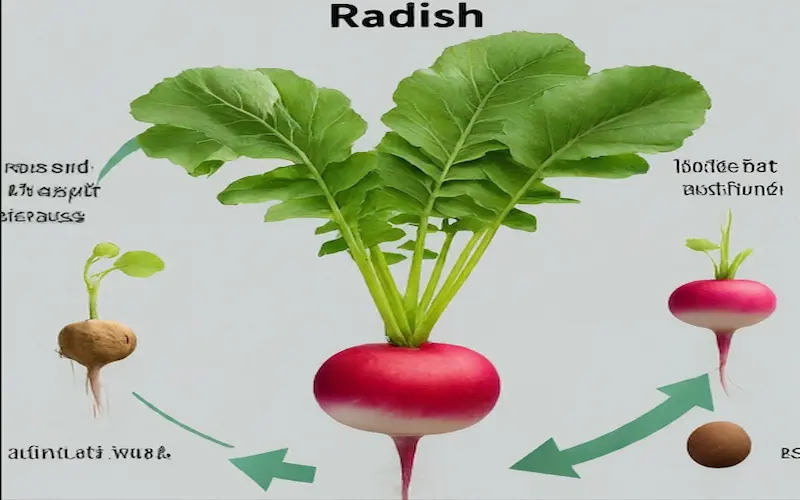
Conclusion
The journey of a radish plant’s growth stages from seed to salad is extraordinary. Each stage unveils a unique set of processes and challenges, from germination to flowering. Understanding and appreciating the radish plant’s growth stages profoundly connects us with these vibrant and nutritious root vegetables.
Radishes thrive in well-drained soil with a pH range of 6.0 to 7.0. They prefer cooler temperatures between 50°F and 70°F. Adequate sunlight, about 6 hours per day, is necessary for their optimal growth.
Under ideal conditions, radish seeds typically germinate within 3 to 7 days. However, temperature, moisture, and seed quality can influence this time frame.
Radishes can be grown indoors with ample sunlight or artificial grow lights. Containers with proper drainage and appropriate potting soil are essential for successful indoor radish cultivation.
Radishes come in various colours, including red, pink, white, and black. Each shade carries a unique flavour profile and appearance, adding diversity to culinary creations.
Yes, radish seeds can be saved for future planting. Properly storing the seeds in an excellent, dry location ensures their viability for future germination and cultivation.

- Be Respectful
- Stay Relevant
- Stay Positive
- True Feedback
- Encourage Discussion
- Avoid Spamming
- No Fake News
- Don't Copy-Paste
- No Personal Attacks



- Be Respectful
- Stay Relevant
- Stay Positive
- True Feedback
- Encourage Discussion
- Avoid Spamming
- No Fake News
- Don't Copy-Paste
- No Personal Attacks


